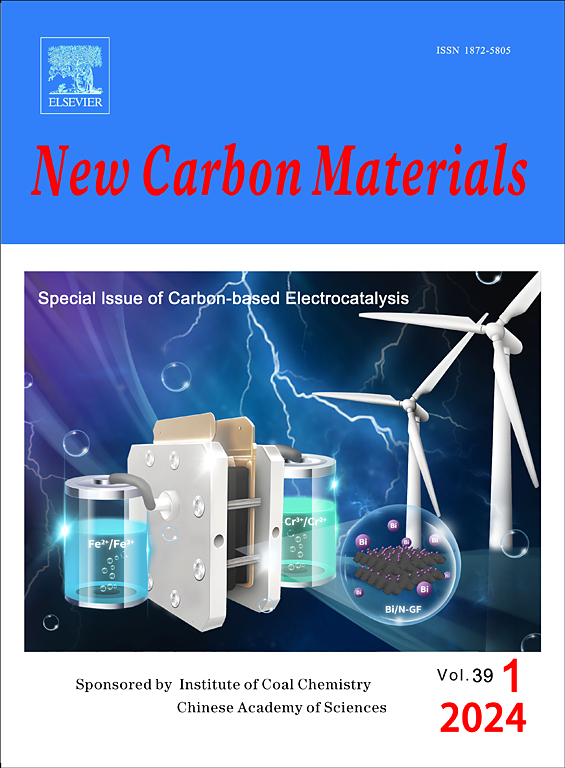利用氮掺杂多孔碳纳米片植入铁和镍的超稳定锂硫电池
IF 5.7
3区 材料科学
Q2 Materials Science
引用次数: 0
摘要
锂硫(li -硫)电池的主要问题是由于阴极氧化还原动力学缓慢和阳极锂枝晶生长而导致循环稳定性差。我们报道了用一种简单且无模板的方法生产掺杂Fe和Ni的二维多孔碳纳米片(Fe/Ni- n - pcnss),从而解决了这一问题。由于其超薄的二维多孔结构和均匀分布的Fe和Ni掺杂剂,可以捕获多硫化物,加快硫的氧化还原反应,提高材料的亲锂性,大大抑制了多硫化物在锂阳极上的穿梭和枝晶生长。因此,它作为单质硫和金属锂的稳定宿主具有优异的性能,在Li-S电池中产生创纪录的1000次循环的长寿命,每次循环的容量衰减极小,为0.00025%,在锂金属电池中具有850小时以上的优异循环稳定性,过电位为>;72 mV。这项工作表明,使用基于多功能的二维多孔碳纳米片作为元素硫和金属锂的稳定宿主,可以提高Li-S电池的性能。下载:下载高分辨率图片(65KB)下载:下载全尺寸图片本文章由计算机程序翻译,如有差异,请以英文原文为准。
Ultra-stable lithium-sulfur batteries using nitrogen-doped porous carbon nanosheets implanted with both Fe and Ni
The major problem with lithium-sulfur (Li-S) batteries is their poor cycling stability because of slow redox kinetics in the cathode and the growth of lithium dendrites on the anode. We report the production of 2D porous carbon nanosheets doped with both Fe and Ni (Fe/Ni-N-PCNSs) by an easy and template-free approach that solve this problem. Because of their ultrathin porous 2D structure and uniform distribution of Fe and Ni dopants, they capture polysulfides, speed up the sulfur redox reaction, and improve the material’s lithiophilicity, greatly suppressing the shuttling of polysulfides and dendrite growth on the lithium anode. As a result, it has an exceptional performance as a stable host for elemental sulfur and metallic lithium, producing a record long life of 1000 cycles with a very small capacity decay of 0.00025% per cycle in a Li-S battery and an excellent cycling stability of over 850 h with a small overpotential of >72 mV in a lithium metal battery. This work suggests the use of multifunctional-based 2D porous carbon nanosheets as a stable host for both elemental sulfur and metallic lithium to improve the Li-S battery performance.
- Download: Download high-res image (65KB)
- Download: Download full-size image
求助全文
通过发布文献求助,成功后即可免费获取论文全文。
去求助
来源期刊

New Carbon Materials
MATERIALS SCIENCE, MULTIDISCIPLINARY-
CiteScore
6.10
自引率
8.80%
发文量
3245
审稿时长
5.5 months
期刊介绍:
New Carbon Materials is a scholarly journal that publishes original research papers focusing on the physics, chemistry, and technology of organic substances that serve as precursors for creating carbonaceous solids with aromatic or tetrahedral bonding. The scope of materials covered by the journal extends from diamond and graphite to a variety of forms including chars, semicokes, mesophase substances, carbons, carbon fibers, carbynes, fullerenes, and carbon nanotubes. The journal's objective is to showcase the latest research findings and advancements in the areas of formation, structure, properties, behaviors, and technological applications of carbon materials. Additionally, the journal includes papers on the secondary production of new carbon and composite materials, such as carbon-carbon composites, derived from the aforementioned carbons. Research papers on organic substances will be considered for publication only if they have a direct relevance to the resulting carbon materials.
 求助内容:
求助内容: 应助结果提醒方式:
应助结果提醒方式:


